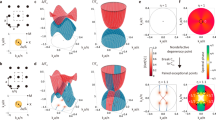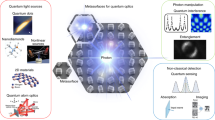Abstract
Versatile interfaces with strong and tunable light–matter interactions are essential for quantum science1 because they enable mapping of quantum properties between light and matter1. Recent studies2,3,4,5,6,7,8,9,10 have proposed a method of controlling light–matter interactions using the rich interplay of photon-mediated dipole–dipole interactions in structured subwavelength arrays of quantum emitters. However, a key aspect of this approach—the cooperative enhancement of the light–matter coupling strength and the directional mirror reflection of the incoming light using an array of quantum emitters—has not yet been experimentally demonstrated. Here we report the direct observation of the cooperative subradiant response of a two-dimensional square array of atoms in an optical lattice. We observe a spectral narrowing of the collective atomic response well below the quantum-limited decay of individual atoms into free space. Through spatially resolved spectroscopic measurements, we show that the array acts as an efficient mirror formed by a single monolayer of a few hundred atoms. By tuning the atom density in the array and changing the ordering of the particles, we are able to control the cooperative response of the array and elucidate the effect of the interplay of spatial order and dipolar interactions on the collective properties of the ensemble. Bloch oscillations of the atoms outside the array enable us to dynamically control the reflectivity of the atomic mirror. Our work demonstrates efficient optical metamaterial engineering based on structured ensembles of atoms4,8,9 and paves the way towards controlling many-body physics with light5,6,11 and light–matter interfaces at the single-quantum level7,10.
This is a preview of subscription content, access via your institution
Access options
Access Nature and 54 other Nature Portfolio journals
Get Nature+, our best-value online-access subscription
$29.99 / 30 days
cancel any time
Subscribe to this journal
Receive 51 print issues and online access
$199.00 per year
only $3.90 per issue
Buy this article
- Purchase on Springer Link
- Instant access to full article PDF
Prices may be subject to local taxes which are calculated during checkout





Similar content being viewed by others
Data availability
The experimental data that support the findings of this study are available from the corresponding author upon reasonable request. Source data are provided with this paper.
Code availability
The simulation results can be generated using the numerical methods described within Methods and Supplementary Information and the computer code developed, which are available upon reasonable request.
References
Chang, D. E., Douglas, J. S., González-Tudela, A., Hung, C.-L. & Kimble, H. J. Quantum matter built from nanoscopic lattices of atoms and photons. Rev. Mod. Phys. 90, 031002 (2018).
Porras, D. & Cirac, J. I. Collective generation of quantum states of light by entangled atoms. Phys. Rev. A 78, 053816 (2008).
Jenkins, S. D. & Ruostekoski, J. Controlled manipulation of light by cooperative response of atoms in an optical lattice. Phys. Rev. A 86, 031602 (2012).
Jenkins, S. & Ruostekoski, J. Metamaterial transparency induced by cooperative electromagnetic interactions. Phys. Rev. Lett. 111, 147401 (2013).
González-Tudela, A., Hung, C. L., Chang, D. E., Cirac, J. I. & Kimble, H. J. Subwavelength vacuum lattices and atom–atom interactions in two-dimensional photonic crystals. Nat. Photon. 9, 320–325 (2015).
Douglas, J. S. et al. Quantum many-body models with cold atoms coupled to photonic crystals. Nat. Photon. 9, 326–331 (2015).
Facchinetti, G., Jenkins, S. D. & Ruostekoski, J. Storing light with subradiant correlations in arrays of atoms. Phys. Rev. Lett. 117, 243601 (2016).
Bettles, R. J., Gardiner, S. A. & Adams, C. S. Enhanced optical cross section via collective coupling of atomic dipoles in a 2D array. Phys. Rev. Lett. 116, 103602 (2016).
Shahmoon, E., Wild, D. S., Lukin, M. D. & Yelin, S. F. Cooperative resonances in light scattering from two-dimensional atomic arrays. Phys. Rev. Lett. 118, 113601 (2017).
Asenjo-Garcia, A., Moreno-Cardoner, M., Albrecht, A., Kimble, H. J. & Chang, D. E. Exponential improvement in photon storage fidelities using subradiance and “selective radiance” in atomic arrays. Phys. Rev. X 7, 031024 (2017).
Noh, C. & Angelakis, D. G. Quantum simulations and many-body physics with light. Rep. Prog. Phys. 80, 016401 (2017).
Lehmberg, R. H. Radiation from an N-atom system. I. General formalism. Phys. Rev. A 2, 883–888 (1970).
Dicke, R. H. Coherence in spontaneous radiation processes. Phys. Rev. 93, 99–110 (1954).
Gross, M. & Haroche, S. Superradiance: an essay on the theory of collective spontaneous emission. Phys. Rep. 93, 301–396 (1982).
Back, P., Zeytinoglu, S., Ijaz, A., Kroner, M. & Imamoğlu, A. Realization of an electrically tunable narrow-bandwidth atomically thin mirror using monolayer MoSe2. Phys. Rev. Lett. 120, 037401 (2018).
Scuri, G. et al. Large excitonic reflectivity of monolayer MoSe2 encapsulated in hexagonal boron nitride. Phys. Rev. Lett. 120, 037402 (2018).
Asenjo-Garcia, A., Hood, J. D., Chang, D. E. & Kimble, H. J. Atom–light interactions in quasi-one-dimensional nanostructures: a Green’s-function perspective. Phys. Rev. A 95, 033818 (2017).
Chomaz, L., Corman, L., Yefsah, T., Desbuquois, R. & Dalibard, J. Absorption imaging of a quasi-two-dimensional gas: a multiple scattering analysis. New J. Phys. 14, 055001 (2012).
Jenkins, S. D., Ruostekoski, J., Papasimakis, N., Savo, S. & Zheludev, N. I. Many-body subradiant excitations in metamaterial arrays: experiment and theory. Phys. Rev. Lett. 119, 053901 (2017).
van Loo, A. F. et al. Photon-mediated interactions between distant artificial atoms. Science 342, 1494–1496 (2013).
Mirhosseini, M. et al. Cavity quantum electrodynamics with atom-like mirrors. Nature 569, 692–697 (2019).
DeVoe, R. G. & Brewer, R. G. Observation of superradiant and subradiant spontaneous emission of two trapped ions. Phys. Rev. Lett. 76, 2049–2052 (1996).
Guerin, W., Araújo, M. O. & Kaiser, R. Subradiance in a large cloud of cold atoms. Phys. Rev. Lett. 116, 083601 (2016).
Solano, P., Barberis-Blostein, P., Fatemi, F. K., Orozco, L. A. & Rolston, S. L. Super-radiance reveals infinite-range dipole interactions through a nanofiber. Nat. Commun. 8, 1857 (2017).
Bloch, I., Dalibard, J. & Zwerger, W. Many-body physics with ultracold gases. Rev. Mod. Phys. 80, 885–964 (2008).
Bakr, W. S., Gillen, J. I., Peng, A., Fölling, S. & Greiner, M. A quantum gas microscope for detecting single atoms in a Hubbard-regime optical lattice. Nature 462, 74–77 (2009).
Sherson, J. F. et al. Single-atom-resolved fluorescence imaging of an atomic Mott insulator. Nature 467, 68–72 (2010).
Weitenberg, C. et al. Single-spin addressing in an atomic Mott insulator. Nature 471, 319–324 (2011).
Meir, Z., Schwartz, O., Shahmoon, E., Oron, D. & Ozeri, R. Cooperative Lamb shift in a mesoscopic atomic array. Phys. Rev. Lett. 113, 193002 (2014).
Preiss, P. M. et al. Strongly correlated quantum walks in optical lattices. Science 347, 1229–1233 (2015).
Ye, J., Kimble, H. J. & Katori, H. Quantum state engineering and precision metrology using state-insensitive light traps. Science 320, 1734–1738 (2008).
Perczel, J. et al. Topological quantum optics in two-dimensional atomic arrays. Phys. Rev. Lett. 119, 023603 (2017).
Bettles, R. J., Minář, J., Adams, C. S., Lesanovsky, I. & Olmos, B. Topological properties of a dense atomic lattice gas. Phys. Rev. A 96, 041603 (2017).
Manzoni, M. T. et al. Optimization of photon storage fidelity in ordered atomic arrays. New J. Phys. 20, 083048 (2018).
Scully, M. O. Single photon subradiance: quantum control of spontaneous emission and ultrafast readout. Phys. Rev. Lett. 115, 243602 (2015).
Guimond, P.-O., Grankin, A., Vasilyev, D. V., Vermersch, B. & Zoller, P. Subradiant Bell states in distant atomic arrays. Phys. Rev. Lett. 122, 093601 (2019).
Černotík, O. V., Dantan, A. & Genes, C. Cavity quantum electrodynamics with frequency-dependent reflectors. Phys. Rev. Lett. 122, 243601 (2019).
Shahmoon, E., Lukin, M. D. & Yelin, S. F. Chapter one – collective motion of an atom array under laser illumination. Adv. Atom. Mol. Opt. Phys. 68, 1–38 (2019).
Shahmoon, E., Lukin, M. D. & Yelin, S. F. Quantum optomechanics of a two-dimensional atomic array. Preprint at https://arxiv.org/abs/1810.01052 (2018).
Bekenstein, R. et al. Quantum metasurfaces with atom arrays. Nat. Phys. 16, 676–681 (2020).
He, Y. et al. Geometric control of collective spontaneous emission. Preprint at https://arxiv.org/abs/1910.02289 (2019).
Henriet, L., Douglas, J. S., Chang, D. E. & Albrecht, A. Critical open-system dynamics in a one-dimensional optical-lattice clock. Phys. Rev. A 99, 023802 (2019).
Zhang, Y.-X., Yu, C. & Mølmer, K. Subradiant bound dimer excited states of emitter chains coupled to a one dimensional waveguide. Phys. Rev. Res. 2, 013173 (2020).
Acknowledgements
We thank J. Ruostekoski, E. Shahmoon, J. I. Cirac, R. Bettles, R. Bekenstein, S. Yelin and M. Zwierlein for discussions. We acknowledge funding by the Max Planck Society (MPG), the European Union (PASQuanS grant number 817482) and the Deutsche Forschungsgemeinschaft (DFG, German Research Foundation) under Germany’s Excellence Strategy – EXC-2111 – 390814868. J.R. acknowledges funding from the Max Planck Harvard Research Center for Quantum Optics. J.Z. acknowledges support through a Feodor Lynen Fellowship by the Humboldt Foundation. D.M.S.-K. acknowledges support through a Carl Friedrich von Siemens Research Award from the Alexander von Humboldt Foundation.
Author information
Authors and Affiliations
Contributions
J.R. acquired the data and, together with D.W. and A.R.-A., maintained and improved the experimental setup. D.W. contributed the theoretical simulations. C.G. and I.B. supervised the study. All authors worked on the interpretation of the data and contributed to the final manuscript.
Corresponding author
Ethics declarations
Competing interests
The authors declare no competing interests.
Additional information
Peer review information Nature thanks Charles Adams, Darrick Chang and the other, anonymous, reviewer(s) for their contribution to the peer review of this work.
Publisher’s note Springer Nature remains neutral with regard to jurisdictional claims in published maps and institutional affiliations.
Supplementary information
Supplementary Information
This file contains Supplementary Text and Supplementary Figures S1–S12.
Rights and permissions
About this article
Cite this article
Rui, J., Wei, D., Rubio-Abadal, A. et al. A subradiant optical mirror formed by a single structured atomic layer. Nature 583, 369–374 (2020). https://doi.org/10.1038/s41586-020-2463-x
Received:
Accepted:
Published:
Issue Date:
DOI: https://doi.org/10.1038/s41586-020-2463-x
This article is cited by
-
Superradiant and subradiant states in lifetime-limited organic molecules through laser-induced tuning
Nature Physics (2024)
-
Organic molecules pumped to resonance
Nature Physics (2024)
-
A switchable atomic mirror
Nature Physics (2023)
-
A subwavelength atomic array switched by a single Rydberg atom
Nature Physics (2023)
-
Universality of Dicke superradiance in arrays of quantum emitters
Nature Communications (2022)
Comments
By submitting a comment you agree to abide by our Terms and Community Guidelines. If you find something abusive or that does not comply with our terms or guidelines please flag it as inappropriate.



